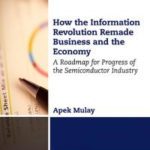Copyright Truthout. Reprinted with permission.
http://truth-out.org/speakout/item/22910-transformation-of-us-semiconductor-industry#a4
Globalization led to the transformation of the entire US Semiconductor Industry from a few Independent Device Manufacturers (IDMs) to several fabless small businesses leading to new innovations in the Microelectronics business. Deceptive “Free Trade” agreements have resulted in not just a transfer of manufacturing technology to China, but also in increased threats of counterfeit electronics entering into the US supply chain [1]. This article explains how US National security may be impacted by the transfer of semiconductor manufacturing technology.
Unsustainable Business Models of US Semiconductor Industry
The growth of the fabless semiconductor industry in the last two decades has been one of the key factors in today’s mobile revolution – which resulted in more silicon consumption for the manufacture of handheld mobile devices as compared to traditional PCs [2]. The recent shift in consumer demand for smart phones over PCs reduced consumer demand for Intel’s processors. Intel’s decision to enter into the wireless business was late, as fabless businesses like Qualcomm, Broadcom, etc. developed a competitive edge over Intel due to matured manufacturing processes at external fabs like Taiwan Semiconductor Manufacturing Corporation (TSMC). This forced Intel to outsource the manufacturing of its wireless business to Asian fabs like TSMC.
Today, Intel Inc. has three idle fabs in Arizona, Oregon and Ireland [3]. These idle fabs have exposed the failure of the IDM business model. Intel has been forced to open up its foundry business to offer manufacturing services for fabless companies in the US and Intel Inc. competes in its business with some of these fabless companies for whom it has opened up its manufacturing services. The flaw in the existing fabless business model of US companies lies in US trade policies. “Free Trade” policies have enabled Asian fabs to manufacture and export goods back into the US without any kind of import duty. This Fabless business model is a major contributing factor in US trade deficits [4].
Advantages of an independent domestic Foundry to US Fabless Semiconductor Industry
There are several advantages to the business model whereby US Fabless businesses get manufacturing done from an independent foundry. First, the US is running a huge annual trade deficit with countries like China and Japan as a result of sending semiconductor manufacturing to these countries. Hence, when manufacturing gets done domestically, the trade deficits would be eliminated over time [5]. Secondly, Free Trade Policies with Asian countries like China have also resulted in a distorted supply chain of manufacturing. The centralized supply chain that is followed by US-based MNCs to increase their annual profits has resulted in rising trade deficits as explained. However, these “free trade” practices have also resulted in the introduction of counterfeit electronics into the US supply chain [1]. It has become very expensive to mitigate introduction of counterfeits into the US supply chain. Thirdly, by creating more jobs domestically, US unemployment could be trimmed and the government would not have to spend money to pay for the unemployment benefits of laid off workers [5].
UAE’s track records on technology re-export
The UAE record on preventing re-export of advanced technology, particularly to Iran, has been mixed in past few years. Taking advantage of geographic proximity and the high volume of Iran-Dubai trade ($10 billion per year), numerous Iranian entities involved in Iran’s energy sector have offices in the UAE that are used to try to procure needed technology and equipment [6]. The Institute for Science and International Security issued a report in January 2009 entitled “Iranian Entities’ Illicit Military Procurement Networks,” which asserted that Iran has used UAE companies to obtain technology from US suppliers, and that the components obtained have been used to construct improvised explosive devices (IEDs) shipped by Iran to militants in Iraq and Afghanistan [6]. The report also alleged that other UAE companies that were involved in this network included not only Mayrow Electronics, but also Majidco Micro Electronics, Micatic General Trading, and Talinx Electronics which are headquartered in Iran [6].
US-UAE Trade deal
According to the statistics from US Census Bureau’s Foreign Trade Division, the UAE has been the largest market for US exports to the Middle East for four years in a row. In 2012, U.S. firms exported nearly $24.81 billion worth of goods to the UAE [7]. In addition to ongoing Free Trade talks between US and UAE, as part of the Gulf Co-operation Council (GCC), the UAE is negotiating with the United States a “GCC-U.S. Framework Agreement on Trade, Economic, Investment, and Technical Cooperation,” an umbrella instrument for promoting ties between the two sides in the economic area – essentially a GCC-wide trade and investment framework agreement (TIFA) [6]. Since GlobalFoundries Inc. has a 300 mm plant planned in Abu Dhabi in 2015, it is obvious that because GlobalFoundries owns the Fab in Malta, New York; it would use this ownership as a leverage to transfer manufacturing technology from its Fab in New York to its upcoming fab in Abu Dhabi. If manufacturing technology does get transferred from New York fab to Abu Dhabi fab in future, Iranian scientists and engineers working in Abu Dhabi could easily get an access to this manufacturing technology due to geographic proximity and high volume trade deal between Iran and Dubai. Free Trade Agreements with China, in past, have resulted in introduction of counterfeit electronics into US Supply Chain and ownership of Trillions of USD by China in its Foreign Exchange (FOREX) reserves [5].
Conclusion
In order to avoid transfer of advanced semiconductor manufacturing technology to politically unstable regions of the world like Iran, which have supported radical Islamist and terrorist groups in Middle East, the US semiconductor industry should have its manufacturing done from a domestic foundry and should not rely on any kind of foreign investments. Therefore, the top notch foundries in US supporting the fabless businesses in US should also have to find a way to become independent of their foreign investors. If domestic fabs in the US decide to go for public offering, based on the history of Wall Street when it comes to capital intensive business, Wall St. would pressurize shareholders of these fabs to ship manufacturing abroad due to high cost of upkeep, maintenance and upgrade of the wafer fab. The other option is to partner with the US government. A symbiotic partnership with the government would make this foundry business of continuous capital investment very sustainable.
Only with backing of US government can any top notch wafer fab be at a leading edge of technology development with sustainable capital investments, helping to keep the foundry independent of any foreign capital. Additionally, ownership of a top notch fab by the US government, as compared to any foreign government, would give confidence to US fabless semiconductor industry in the area of Intellectual Property protection for those Fabless businesses. To keep this partnership with the US government symbiotic and efficient, the business model of the US semiconductor industry should transform from a Globalization-based model to a sustainable business model. One such model has been presented in my paper “A Three Tier Business Model for the Semiconductor Industry” [7]. This would transform the entire US semiconductor industry to generate high profits for years to come. Such a transformation of industry would take the US Semiconductor industry to its next level of innovation and financial success [8].
References
[1] A Mulay, Electronic Device Failure Analysis Magazine,”Mitigation of Counterfeit Electronics through Macro-economic Policies”, May 2013, Pgs.45-47 (Volume 15 Issue 2).
[2] Daniel Nenni, Semiwiki, ‘The Semiconductor IDM Business Model is Dead!’, 10 July 2013. https://www.semiwiki.com/forum/content/2570-semiconductor-idm-business-model-dead.html
[3] Daniel Nenni, Semiwiki, ‘Intel Wafer Pricing Exposed’, 28 December 2013. https://www.semiwiki.com/forum/content/3032-exposed-intel-wafer-pricing.html#sthash.DeoGEOZ9.dpuf
[4] Apek Mulay and Dhanjoo Ghista, electronics.ca publications, ‘Revival of US Electronics and Semiconductor Industry and Mitigation of Counterfeit Electronics through Macro-Micro Economic Policies, towards (i) Recovery from Trade and Budget Deficits and National Debt, and (ii) Engendering US Economic Growth’, 29 October 2013. http://www.electronics.ca/presscenter/articles/2118/1/Revival-of-US-Electronics-and-Semiconductor-Industry-and-Mitigation-of-Counterfeit-Electronics-through-Macro-Micro-Economic-Policies-towards-i-Recovery-from-Trade-and-Budget-Deficits-and-National-Debt-and-ii-Engendering-US-Economic-Growth/Page1.html#!
[5] Apek Mulay, Truthout.org, ‘A Failure Analysis of the US Economy’, 2 March 2013. http://www.truth-out.org/news/item/14887-a-failure-analysis-of-the-us-economy#
[6] Kenneth Katzman, Specialist in Middle Eastern Affairs, The United Arab Emirates (UAE): Issues for U.S. Policy, Congressional Research Service, 17 October 2013.
[7] US-UAE Business Council, Record-breaking U.S. export numbers showcase vibrant U.S.-U.A.E. trade growth, 8 February 2013. http://usuaebusiness.org/2013/02/record-breaking-u-s-export-numbers-showcase-vibrant-u-s-u-a-e-trade-growth/#sthash.FX4sl50L.dpuf
[8] Apek Mulay, electronics.ca publications, ‘A Three Tier Business Model for the Semiconductor Industry’, 9 December 2013. http://www.electronics.ca/presscenter/articles/2152/1/A-Three-Tier-Business-Model-for-the-Semiconductor-Industry/Page1.html#!


Recent Comments